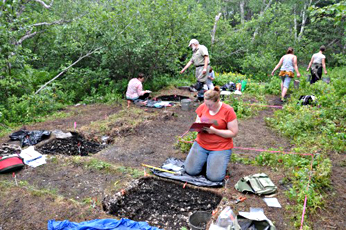History at the tip of a trowel
August 25, 2010
The thought of archaeology brings to mind some famous sites: the pyramids of Egypt, Pompeii, Persepolis, Machu Picchu. Imagine how many pages of history they have helped write. Closer to home, we might think of Place Royale in Quebec or Head-Smashed-In Buffalo Jump in Alberta. But who would have thought that with a bit of digging, there is so much to uncover along the coasts of Nova Scotia?
Two thousand years of scraps
Ever wonder how the First Peoples of Atlantic Canada lived? Some exciting clues are hidden in Port Joli, a shallow bay on the south coast of Nova Scotia. That’s where a team of researchers has chosen to call home for part of the summer. Led by Matthew Betts, Ph.D. – Curator of Atlantic Provinces Archaeology at the Canadian Museum of Civilization – the E’se’get Project is digging into the lifestyle of the Mi’kmaq who have lived there around 2000 years.
Worn by waves and wind over so many years, this coast may seem like a strange place for research. But the dig is focused on important shell middens comprised mainly of clams, mussels, and snails. These middens are, in fact, remnants of meals gone by, like piles of table scraps. Protected by transformed Maritime soil, stone tools, pottery pieces, fish, animals, and bird bones have lain for centuries, waiting to reveal their secrets. Thanks to extremely high concentration of calcium carbonate in the shells, earth that is normally acidic enough to dissolve animal bones and antlers now yields a veritable treasure trove of organic remains.
Launched in 2008, this project brings the Museum into collaboration with several impressive partners: the Acadia First Nation, University of New Brunswick, and the provincial Department of Natural Resources.
Archaeology 2.0
Educational value and community involvement are what make the E’se’get Project especially notable. Mi’kmaq high school students are getting archaeological training while staying in a traditional camp and area residents and tourists can observe the dig from up close.

But access doesn’t end there. For those who won’t have the chance to visit Thomas Raddall Provincial Park, Matthew Betts and his team have taken archaeology to the Web. Through their blog, we get to share the highs and lows of their great adventure.
Check out the unearthed secrets of the banks of Port Joli on screen – from gear prep to meal prep, from dig techniques to daily finds, an archaeologist’s work is no longer a secret. Or almost.
Marshalltown trowels and a “stratigraphy sandwich” await you.